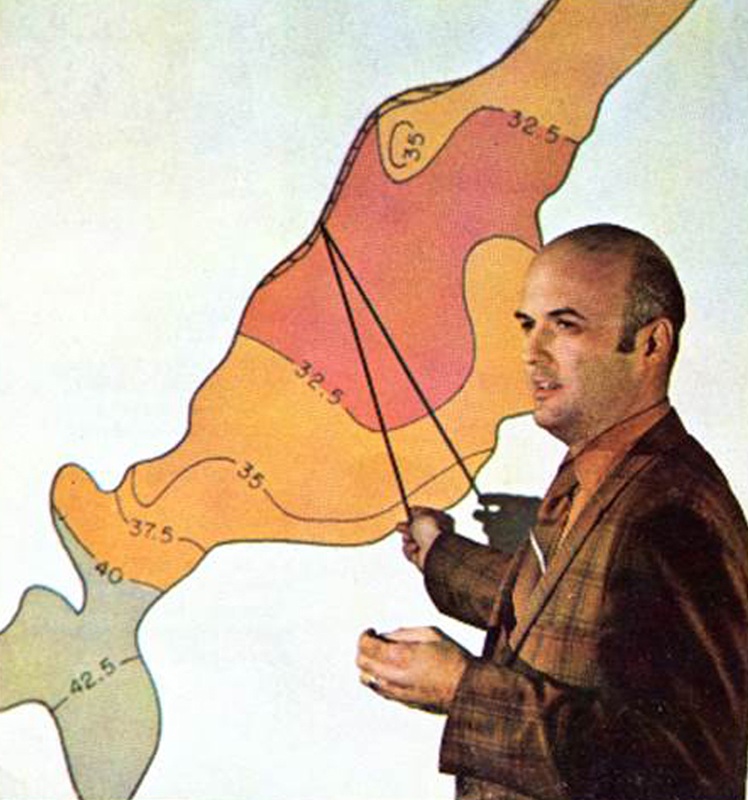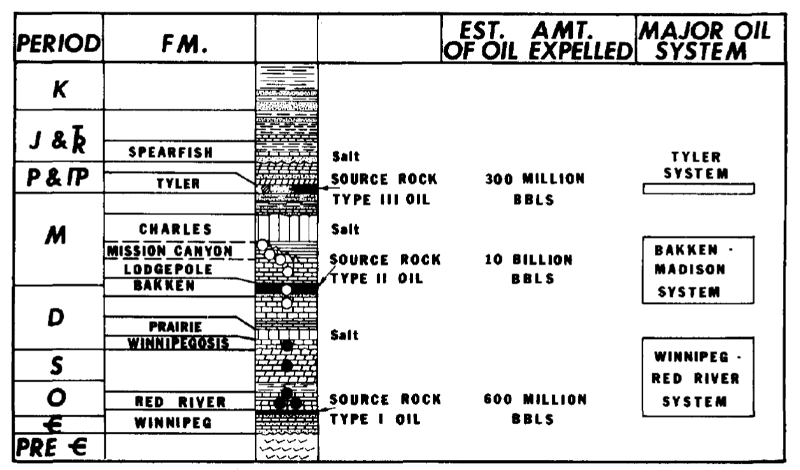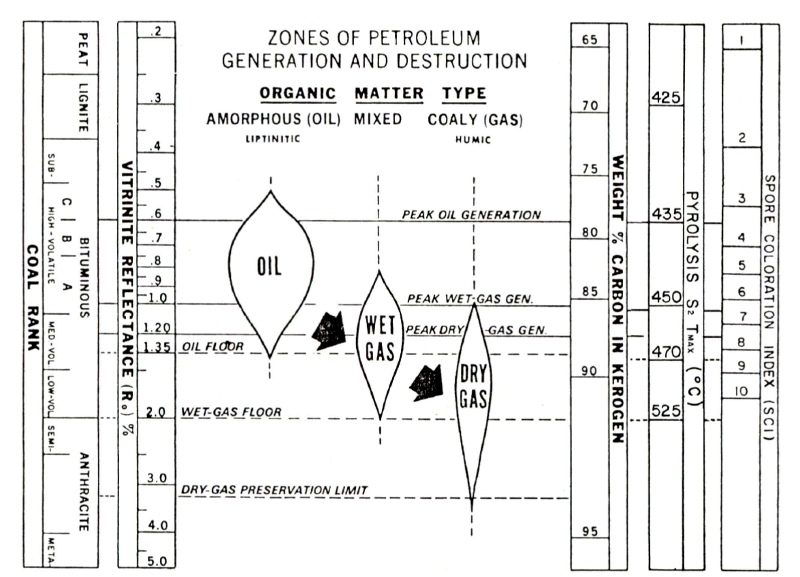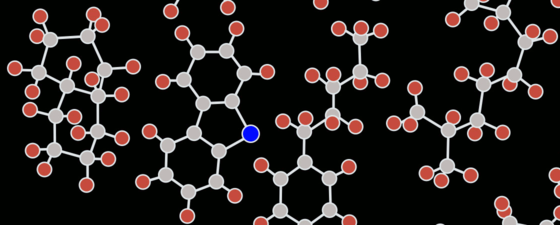 Wallace Dow. Courtesy of W. Dow.Wallace Gilmore Dow was born on June 4, 1937 in New Jersey and grew up in that state. He found his love for chemistry in high school. “In those days,” Dow recalls, “there were four major science subjects in my high school: physics, chemistry, biology, and something called physiography, a combination of astronomy, meteorology, and geology, and two were required for graduation. Physics did not appeal to me and I did not fancy cutting up frogs in biology, so I chose chemistry and physiography which became my first introduction to geology.”
Wallace Dow. Courtesy of W. Dow.Wallace Gilmore Dow was born on June 4, 1937 in New Jersey and grew up in that state. He found his love for chemistry in high school. “In those days,” Dow recalls, “there were four major science subjects in my high school: physics, chemistry, biology, and something called physiography, a combination of astronomy, meteorology, and geology, and two were required for graduation. Physics did not appeal to me and I did not fancy cutting up frogs in biology, so I chose chemistry and physiography which became my first introduction to geology.”
In 1955, Dow entered Rutgers University in New Brunswick, N. J. and graduated in geology four years later. After serving in the US Army for three years, Dow applied for a Master’s program in geology at several universities. He selected the University of North Dakota in Grand Forks because “they sent me a telegram saying that they would waive my tuition fees and even pay me money. Not a bad deal for a penniless student.” In 1964, Dow graduated with an M.S. with honors in Geology and Stratigraphy. In the same year, his first research papers were published: ‘Effect of the salinity on the formation of mud cracks’ in The Compass of Sigma Gamma Epsilon, and a paper on the Spearfish Formation (Triassic Red Beds) in the Williston Basin of North Dakota (in Third Williston Basin Symposium Guidebook), which was actually his Master’s thesis and was formally published as the North Dakota Geological Survey Bulletin 52.
Williston Basin
“In the subsurface of the Williston Basin in western North Dakota, the Spearfish Formation can be divided into three lithologic units. In ascending order these are: (1) a lower gray shale and red siltstone unit, (2) a middle salt unit, and (3) an upper red siltstone, shale, and fine grained sandstone unit.” (Dow, 1964)
With a significant oil discovery in 1951, the Williston Basin was a hotspot for oil exploration during the 1950s and 60s, and the University of North Dakota and the North Dakota Geological Survey held a central position in studies of the basin. It was only logical for Dow to focus his Master’s research there. His thesis advisor was Walter Moore, a geologist who had worked for Gulf Oil before joining the University in 1960. Dow was also supported by the department chair and State Geologist Wilson Laird (1915–1977), a prominent geologist in North Dakota who later served as the AAPG President as well as Director of the Office of Oil and Gas in the US Department of the Interior (1969–71).
 Wallace Dow during a presentation of his research work in 1971. Courtesy of W. Dow.It was also at North Dakota that Dow met his would-be wife and life-long companion Marlys, who had taken a geology laboratory class in 1963 for which Dow was a teaching assistant. “I needed someone to type my Master’s thesis,” Dow admits, “and she pretended to need tutoring.” They married in August 1965, a year after Dow had got his first job as a geologist for Pan American Production Company (later Amoco). Initially, Dow worked in Casper, Wyoming where he studied Mesozoic sandstones of the Rocky Mountain basins and in 1965 the company moved to Denver, Colorado. He spent the next four years alternating as a well-site geologist and working on Paleozoic carbonates, especially the Ordovician Red River Formation. “When my first son Thomas was born in Denver in 1967, I was in the field drilling Pan American Hove No. 1 into naturally fractured Bakken Shale. I rushed to Denver when I was informed of his birth, eight weeks early.” Dow’s second son Kevin was born in 1968. The Dows now have five grandchildren.
Wallace Dow during a presentation of his research work in 1971. Courtesy of W. Dow.It was also at North Dakota that Dow met his would-be wife and life-long companion Marlys, who had taken a geology laboratory class in 1963 for which Dow was a teaching assistant. “I needed someone to type my Master’s thesis,” Dow admits, “and she pretended to need tutoring.” They married in August 1965, a year after Dow had got his first job as a geologist for Pan American Production Company (later Amoco). Initially, Dow worked in Casper, Wyoming where he studied Mesozoic sandstones of the Rocky Mountain basins and in 1965 the company moved to Denver, Colorado. He spent the next four years alternating as a well-site geologist and working on Paleozoic carbonates, especially the Ordovician Red River Formation. “When my first son Thomas was born in Denver in 1967, I was in the field drilling Pan American Hove No. 1 into naturally fractured Bakken Shale. I rushed to Denver when I was informed of his birth, eight weeks early.” Dow’s second son Kevin was born in 1968. The Dows now have five grandchildren.
What drew Dow to petroleum geochemistry was not only his interest in chemistry, but also his unique situation: “As a well-site geologist I collected hundreds of oil samples for the new Amoco geochemistry lab in Tulsa, Oklahoma to analyze.” In 1969, Dow was transferred to Amoco’s Research Center in Tulsa where he was responsible for interpretation of geochemical data and prepared over 100 internal reports covering many US and overseas exploration blocks. There, he enrolled in the Ph.D. program in organic geochemistry and business management at Tulsa University (1970–1972) and took classes from legends like Colin Barker, Parke Dickey and Norman Hyne. In 1972, Dow left to work for The Superior Oil Company in Houston and never completed his Ph.D. degree.
‘Oil System’
“Most Williston basin oils belong to one of three basic types… isolated vertically by evaporates… All three oil types can be correlated to their source facies. Lithofacies maps of these source sequences, when combined with thermal alteration measurements, provide effective oil-source-area definition.” (Dow, 1974)
 ‘Oil systems’ for the Williston Basin proposed by Wallace Dow in AAPG Bulletin in 1974. This was a germinal idea for what was later developed as the petroleum system analysis in the 1980s. Courtesy of W. DowWhile at Amoco Research, Dow and organic chemist Jack A. Williams developed the idea of oil-to-source rock correlation based on geochemical data from the Williston and several other basins and presented it to one of the company’s vice-presidents who flew in from Chicago. “We basically handed him the concept of what later came to be known as ‘the petroleum system’, but he was unimpressed and declared it of little use in petroleum exploration! The bright side was that the company permitted us to present our work at the AAPG Annual Convention in 1972 in Denver in a session entitled ‘New Ideas in Petroleum Exploration’ which was later published in the 1974 AAPG Bulletin.” Dow suggested “three major source-reservoir oil systems” for the Williston Basin: (1) the Winnipeg-Red River oil system below the Devonian Prairie salt; (2) the Bakken-Madison oil system between the Devonian Prairie and Mississippian Charles salts; and (3) the Tyler system above the Mississippian Charles salts.
‘Oil systems’ for the Williston Basin proposed by Wallace Dow in AAPG Bulletin in 1974. This was a germinal idea for what was later developed as the petroleum system analysis in the 1980s. Courtesy of W. DowWhile at Amoco Research, Dow and organic chemist Jack A. Williams developed the idea of oil-to-source rock correlation based on geochemical data from the Williston and several other basins and presented it to one of the company’s vice-presidents who flew in from Chicago. “We basically handed him the concept of what later came to be known as ‘the petroleum system’, but he was unimpressed and declared it of little use in petroleum exploration! The bright side was that the company permitted us to present our work at the AAPG Annual Convention in 1972 in Denver in a session entitled ‘New Ideas in Petroleum Exploration’ which was later published in the 1974 AAPG Bulletin.” Dow suggested “three major source-reservoir oil systems” for the Williston Basin: (1) the Winnipeg-Red River oil system below the Devonian Prairie salt; (2) the Bakken-Madison oil system between the Devonian Prairie and Mississippian Charles salts; and (3) the Tyler system above the Mississippian Charles salts.
Ten years later, Dow teamed up with Leslie B. Magoon (then at US Geological Survey) and formalized the original ‘oil-system’ ideas into the ‘petroleum system’ concept, culminating in AAPG Memoir 60 titled The Petroleum System: From Source to Trap, edited by Magoon and Dow. This volume, still the ‘Bible’ in its field, won the AAPG Robert H. Dott, Sr. Memorial Award for the best special publication of 1994. (See Following the Oil Through Time by Thomas Smith for more about petroleum systems.)
Thermal Maturity
“The primary purpose of kerogen maturation is to determine whether petroleum has been generated in source beds.” (Dow, 1977)
 The famous droplet diagram showing the correlation of maturity indicators for oil and gas windows first presented by Wallace Dow in the Journal of Geochemical Exploration in 1977. Courtesy of W. Dow.Dow left Amoco to work for The Superior Oil Company in Houston because they had just begun using reflected light microscopy to study kerogen and Dow recognized it as an important new frontier in petroleum geochemistry. He hired Dolores O’Connor to do most of the microscopy work and together they advanced geochemical techniques and interpretations for the characterization of sedimentary organic matter including vitrinite reflectance (VR), which is now commonly used by oil explorers to assess the thermal maturity of source rocks. The VR technique was originally developed for ranking of coal with burial depth and temperature, but its application to petroleum source rocks revolutionized both the technique and petroleum geology. Dow and O’Connor’s 1982 SEPM report is still a useful guide to the VR technique. Dow extended his studies to kerogen typing and published a seminal paper titled ‘Kerogen studies and geological interpretations’ in the Journal of Geochemical Exploration (1977), which remains one of his most cited works.
The famous droplet diagram showing the correlation of maturity indicators for oil and gas windows first presented by Wallace Dow in the Journal of Geochemical Exploration in 1977. Courtesy of W. Dow.Dow left Amoco to work for The Superior Oil Company in Houston because they had just begun using reflected light microscopy to study kerogen and Dow recognized it as an important new frontier in petroleum geochemistry. He hired Dolores O’Connor to do most of the microscopy work and together they advanced geochemical techniques and interpretations for the characterization of sedimentary organic matter including vitrinite reflectance (VR), which is now commonly used by oil explorers to assess the thermal maturity of source rocks. The VR technique was originally developed for ranking of coal with burial depth and temperature, but its application to petroleum source rocks revolutionized both the technique and petroleum geology. Dow and O’Connor’s 1982 SEPM report is still a useful guide to the VR technique. Dow extended his studies to kerogen typing and published a seminal paper titled ‘Kerogen studies and geological interpretations’ in the Journal of Geochemical Exploration (1977), which remains one of his most cited works.
Dow and O’Connor left Superior Oil when management changed and after a short stint at Getty Oil joined Robertson Research (US) Inc. in Houston. In the 1970s, through his interactions with international conferences like International Meeting on Organic Geochemistry, the Gordon Research Conference on Organic Geochemistry, and AAPG meetings and conferences, Dow was befriended by many of the pioneers in the field, including Alfred Treibs (the father of organic geochemistry), John Hunt (author of Petroleum Geochemistry and Geology, 1979, 1995), Bernard P. Tissot and Dietrich H. Welte (authors of Petroleum Formation and Occurrence, 1978, 1984). Hunt, Tissot and Welte, who wrote the first textbooks on petroleum geochemistry, cited Dow’s papers. Dow regards the American geologist Parker Trask (1899–1961) and the German organic chemist Alfred Treibs (1899–1983) as two giants who began petroleum geochemistry during the Great Depression of the 1930s. Dow also wrote a biography of John Hunt (1918–2005) on his seventieth birthday in 1988, published in a proceedings volume, Organic Matter (Columbia University Press, 1992).
Deepwater Petroleum Source Rocks
“Continental slopes commonly are sites of high marine organic productivity and frequently contain reducing bottom conditions, quiet water, and intermediate sedimentation rates, all of which favor deposition of organic-rich sediments.” (Dow, 1978)
The oil industry aggressively moved to explore deepwater basins in the 1970s. Although our knowledge of deepwater plays has increased over time, questions about petroleum source rocks in these basins is still hotly debated. It is, therefore, of interest to note Dow’s 1978 AAPG Bulletin paper titled (far ahead of its time) ‘Petroleum source beds on continental slopes and rises.’ This paper resulted from Dow’s involvement in the geochemical analysis of cuttings and cores from the offshore Gulf Coast and Atlantic coast (drilled as part of the US Continental Offshore Stratigraphic Test program) as well as those from several bore holes of the Deep Sea Drilling Project offshore North Atlantic. For the Gulf of Mexico, Dow found that the organic carbon content increases from shelf/neritic (0.23%) to bathyal/abyssal (0.60%) sediments.
DGSI and Recent Years
“My life philosophy is this: if you have a lemon, make lemonade. Faced with a failure and hardship, work hard and turn adversity into something even more successful. Publishing papers helps our professional career.” (Dow in an interview with the author).
In 1983, when the global oil market collapsed, the Robertson Research (US) laboratory in Houston closed down, throwing many people out of work. Almost in desperation, Dow and his wife Marlys formed Dow Geochemical Services Inc. (later known as DGSI), which became one of the most active geochemical services companies for the oil industry during the following 16 years. It also trained a number of petroleum geochemists who later obtained leading positions in the industry. In 2000, DGSI was sold to Baseline (now part of Weatherford). During 2001–06, Dow was an independent geochemical consultant for several oil companies until one of these companies, EOG Resources in Houston, offered him the position of Chief Geochemist. Interest in petroleum geochemistry was literally ‘born again’ when oil source rocks became reservoirs in unconventional oil plays. In 2011, Dow retired, but ever a man in love with his job and science, he started another tenure as Chief Geochemist for Cimarex Energy Co. in Tulsa, Oklahoma where he and his wife currently live. The 1970s witnessed the emergence of the geochemistry of petroleum source rocks. It is apt to end this essay with a statement Dow made in his 1977 paper: “As petroleum becomes more difficult to find and the search more expensive, the utilization of modern technology, including organic geochemistry, will play an increasingly important role in petroleum exploration.” This statement is still valid and very much so for the unconventional shale gas plays such as those in the Williston basin where Dow began his fruitful career five decades ago.
In 2000, Wallace Dow was awarded the Arthur Gray Leonard Medal by the University of North Dakota for “outstanding achievement in the geosciences, especially in geochemical research and petroleum exploration and development.”





